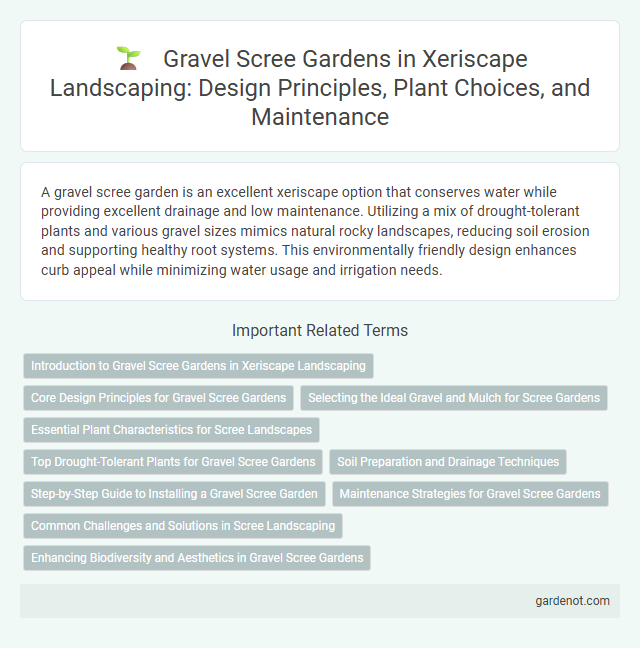A gravel scree garden is an excellent xeriscape option that conserves water while providing excellent drainage and low maintenance. Utilizing a mix of drought-tolerant plants and various gravel sizes mimics natural rocky landscapes, reducing soil erosion and supporting healthy root systems. This environmentally friendly design enhances curb appeal while minimizing water usage and irrigation needs.
Introduction to Gravel Scree Gardens in Xeriscape Landscaping
Gravel scree gardens in xeriscape landscaping utilize well-draining, coarse gravel to mimic natural mountainous scree slopes, promoting drought-resistant plant growth and soil stability. These gardens require minimal irrigation, making them ideal for arid regions by reducing water consumption and maintenance. Incorporating native succulents, grasses, and hardy shrubs enhances biodiversity while complementing the gravel's texture and color for a visually striking, sustainable landscape.
Core Design Principles for Gravel Scree Gardens
Gravel scree gardens emphasize water-efficient landscaping by integrating drought-tolerant plants with well-draining rocky substrates, promoting soil moisture retention and erosion control. Core design principles include selecting native or adapted xerophytic species, arranging plants to mimic natural scree slopes, and incorporating varied gravel sizes to enhance aeration and stability. Proper layering of coarse and fine gravel ensures optimal drainage while supporting root health in arid environments.
Selecting the Ideal Gravel and Mulch for Scree Gardens
Selecting the ideal gravel and mulch for scree gardens is crucial to enhancing drainage and preventing soil erosion in xeriscape landscapes. Opt for angular gravel in sizes ranging from 3/8 to 1/2 inch to create stable surfaces that support plant roots and facilitate water infiltration. Incorporating organic mulch such as shredded bark or pine needles helps retain moisture while gradually enriching the soil without disrupting the natural arid ecosystem.
Essential Plant Characteristics for Scree Landscapes
Plants suited for gravel scree gardens exhibit drought tolerance, deep root systems, and low nutrient requirements, essential for thriving in well-drained, nutrient-poor soils. Compact growth habits, tolerance to temperature extremes, and resistance to wind erosion are crucial for stability on loose, rocky substrates. Xerophytic adaptations such as succulent leaves or hairy foliage enhance water retention and minimize evaporation in scree landscapes.
Top Drought-Tolerant Plants for Gravel Scree Gardens
Gravel scree gardens thrive with drought-tolerant plants such as Sedum, Agave, and Echeveria, which require minimal water and adapt well to rocky, well-drained soils. These succulent species store water efficiently, making them ideal for xeriscape landscapes designed to conserve moisture. Incorporating native grasses like Blue Fescue and Artemisia enhances soil stability and drought resilience within gravel scree environments.
Soil Preparation and Drainage Techniques
Gravel scree gardens require well-drained soil with a sandy or gritty texture to prevent water retention and root rot, making soil amendment with coarse sand or small gravel essential for optimal drainage. Incorporating a layer of crushed rock or gravel beneath the planting area enhances water runoff and minimizes soil compaction, promoting healthy root systems. Proper grading and contouring ensure efficient water flow away from plant roots, supporting drought-tolerant xeriscape plants in low-water environments.
Step-by-Step Guide to Installing a Gravel Scree Garden
Installing a gravel scree garden begins with selecting a well-drained, sunny location, then preparing the site by removing existing vegetation and leveling the soil. Next, spread a layer of landscape fabric to suppress weeds, followed by layering various sizes of gravel and scree to mimic natural rocky slopes and ensure proper drainage. Finally, plant drought-tolerant, alpine-adapted species like sedum, hens-and-chicks, and ornamental grasses, spacing them to allow growth and creating an aesthetically pleasing, water-efficient xeriscape.
Maintenance Strategies for Gravel Scree Gardens
Effective maintenance strategies for gravel scree gardens prioritize weed control by applying pre-emergent herbicides and manually removing invasive plants to preserve the garden's aesthetic and ecological balance. Regularly inspecting and replenishing gravel helps maintain proper drainage and prevents soil erosion, which is vital for xeriscape sustainability. Mulching around drought-tolerant plants enhances moisture retention and reduces evaporation, further minimizing water usage in arid landscapes.
Common Challenges and Solutions in Scree Landscaping
Gravel scree gardens often face challenges such as soil erosion, poor drainage, and weed invasion, which can undermine plant health and design integrity. Solutions include installing proper grading to facilitate water runoff, incorporating a weed barrier fabric beneath the gravel, and selecting drought-tolerant, deep-rooting native plants to stabilize the soil. Regular maintenance like raking and replenishing gravel helps preserve the aesthetic appeal and functionality of the xeriscape scree garden.
Enhancing Biodiversity and Aesthetics in Gravel Scree Gardens
Gravel scree gardens enhance biodiversity by providing habitat for drought-tolerant plants and pollinators, promoting ecological balance in arid landscapes. The varied textures and colors of gravel combined with native succulent and alpine species create visually striking contrasts that boost garden aesthetics. This xeriscape approach conserves water while supporting local wildlife and offering a low-maintenance, sustainable design.
Gravel scree garden Infographic

 gardenot.com
gardenot.com